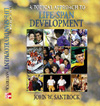 |  Life-Span Development: A Topical Approach John W. Santrock
Biological Process, Physical Development, and Health Physical Development and Biological Aging
Learning Objectives1.Understand how the body grows and changes from birth through adolescence so that you can:- Distinguish between cephalocaudal and proximodistal growth patterns
- Describe the physical changes from infancy through childhood, including those in height and weight
- Describe the physical, hormonal, and psychological changes that take place during puberty
- Discuss how the timing of pubertal changes impacts females and males
|
 |  |  | 2.Describe the patterns of body growth and physical changes throughout the adult years, particularly addressing:- Peaks and declines in height and muscle tone through the twenties and thirties
- Gradual changes in middle adulthood
- Outwardly noticeable physical changes in late adulthood, including decreased height, weight, and muscle
|
 |  |  | 3.Discuss changes in brain organization and structure throughout the life span, including the impressive changes in dendritic spreading and specialization during infancy, the spurts of brain activity from childhood through early adolescence, and the newly discovered evidence for continued brain cell growth and rewiring that occurs in older adulthood. |
 |  |  | 4.Compare sleep patterns of infants, children, adolescents, and adults and how sleeping arrangements with infants vary across cultures, and address the concern about adults not getting sufficient sleep. |
 |  |  | 5.Contrast life expectancy with life span, including how the former has changed and explanations for sex differences. |
 |  |  | 6.Differentiate between the young old, old old, and oldest old in terms of chronological age and explain why many experts prefer to look at functional age rather than chronological age to explain why some oldest old are more biologically and psychologically fit than some young old. |
 |  |  | 7.Discuss the cellular clock, free-radical, and hormonal stress theories of aging. |
|



 2002 McGraw-Hill Higher Education
2002 McGraw-Hill Higher Education